Challenge Adrian
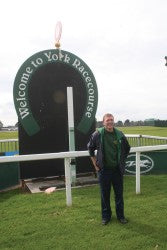 Head Groundsmen are expected to fulfil many roles these days - soil scientist, mechanic, civil engineer, diplomat, man manager, strategic planner, finance expert - and those at the top of their profession carry a level of responsibility equal to many a captain of industry or equivalent practitioner in medicine or law.
Head Groundsmen are expected to fulfil many roles these days - soil scientist, mechanic, civil engineer, diplomat, man manager, strategic planner, finance expert - and those at the top of their profession carry a level of responsibility equal to many a captain of industry or equivalent practitioner in medicine or law.
With these wider responsibilities comes the opportunity to work with an expanded team, both from their own organisation and from expert companies; the days when the groundsman never saw the office are long gone.
When York Racecourse started looking for a new Head Groundsman, there was quite a challenge awaiting the successful applicant. The track is rightly world famous for races such as the totesport Ebor or Juddmonte International, yet these prestigious contests are run on a piece of turf surface that asks as many questions of its steward as it does of the jockeys.
The land, known as the Knavesmire, is a former ice-age lake and now is actually a flood plain that safeguards parts of the historic city from the nearby River Ouse. This major waterway not only carries rainwater from the North Yorkshire Moors but, given that it flows into the Humber, is tidal to boot.
The proximity of the course to the city means that it is always popular with dog owners and picnickers, whilst the open space in the middle of the Knavesmire provides a home ground for several football teams. Combine the geography of the area with the public demands placed upon it and the challenge of improving the track becomes clear.
York appointed Adrian Kay in October 2006, in time for him to join the planning phase of a scheme that would see £2.5 million invested in the racing surface. "One of the many reasons for coming to York was being part of a track project of this nature and to be able to have an input" Adrian says. "We were seeking to make one of the biggest improvements to the racing surface at York in a proud history that dates back to 1731; there were already some great people involved and, whilst it was a challenge, I consider that it is quite an honour to be part of it."
There was already a strong working relationship between Clerk of the Course, William Derby, and Mike Harbridge from Professional Sportsturf Design (PSD). Joined by Adrian, the trio undertook a lengthy and iterative approach to the design which was to include a comprehensive drainage and irrigation scheme, a new service road as well as a widening of the track on its home bend.
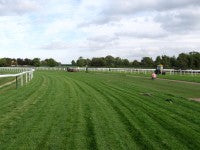
The design phase naturally led to the appointment of key partners, with John Mallinson (Ormskirk) Ltd appointed main contractor, Arden Lea of Southport as irrigation specialists and, finally, Lindum Turf as the providers of the high quality turf required.
Adrian had arrived at York having come to racecourse groundsmanship via a roundabout route, beginning at a bowls club in the south of England where he worked for a local council contractor. "I realised then that I wanted to be involved with the green stuff, although the term turf management was news to me," he recalls, "and so I went into greenkeeping." As Assistant Head Greenkeeper at Aintree golf course, Adrian was working surrounded by another of the most famous racecourses in the world. "We were on a 9 hole golf course situated in the middle of the race track which hosted the Grand National," he explains, "and I couldn't help but get involved."
He took his HND in Turf Science and Sportsground Management and developed to become Head Groundsman at Aintree. "There was plenty to learn as I switched to meeting the needs of a different type of handicapper," he admits, "and I will always be grateful that I had a good team round me. A racecourse is a very different beast compared with a golf course. If you think that a few nine irons can take some divots out of the turf, wait until you see what a hundred horses making four hoofprints a stride can do."
Mike Harbridge has been involved at York for many years as a consultant agronomist and, back in 2006, he had been asked by William Derby to undertake a full audit of the racing surface, looking at everything from soil type, grass species, topography and the existing irrigation system and pumphouse. He suggested that the first step be the construction of a tarmac service road running right round the inside of the course. Without this, access of machinery essential to carry out alterations to the track itself would have been impossible.
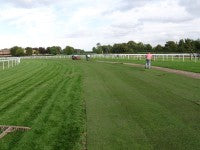 "The City of York Council, as ultimate owner of the Knavesmire, were very supportive and recognised the importance of the racecourse and its racing surface to the City," Mike recalls. "The new access road, (75mm tarmac on top of 350mm sub-base) not only serves emergency vehicles and veterinary surgeons on race days but is used by joggers, walkers, cyclists and wheelchair users outside of races." Started in November 2007, construction of the service road carried on right through that extremely wet winter.
"The City of York Council, as ultimate owner of the Knavesmire, were very supportive and recognised the importance of the racecourse and its racing surface to the City," Mike recalls. "The new access road, (75mm tarmac on top of 350mm sub-base) not only serves emergency vehicles and veterinary surgeons on race days but is used by joggers, walkers, cyclists and wheelchair users outside of races." Started in November 2007, construction of the service road carried on right through that extremely wet winter.
Now part of the project team, Mallinsons, began construction on the 7 x 225mm carrier drains and on the main collector drains inside the running rail during February and March 2008, "The Knavesmire is quite flat," explains John Mallinson, "and it's served by a central, culvert going into the river. We needed to install a number of outfalls going from the main drain, so that the whole area could be drained without any one outfall having to be constructed at too deep an angle."
In late spring 2008, work began on a ten metre wide extension to the Home (south) bend, consisting of a 150mm sand carpet, underlying a 250mm sand/soil mix. "We completed everything right up to the turf laying stage, knowing that we would have to come back to install the main track drainage once the racing season was over," John continues.
Adrian, along with his deputy, John Morley, and Mike Harbridge had already chosen his turf, which was being grown eight miles away at the Lindum turf farm in Thorganby. "I knew that I wanted locally grown turf as it would be produced on a similar soil type to the Knavesmire" Adrian explains. "We went to see a few local turf growers and decided that Lindum had the right sports turf grass type for us." Twelve thousand six hundred square metres of the company's LT6, a high ryegrass and smooth stalked meadow grass mixture, were ordered ready for harvest during the winter of 2008 when it would finally be laid on the south bend extension. 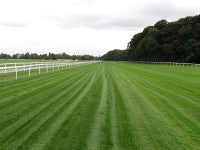
LT6 had been used successfully on the new north bend, completed in preparation for the Royal Ascot meeting hosted by York Racecourse prior to Adrian's arrival. It also had a further racing pedigree after being chosen for extensive improvements at Haydock Park and the new bend at Ripon two years ago.
What happened next in 2008 was the wettest July and August on record, circumstances that left the team coping with the first ever abandonment of the Ebor Festival due to waterlogging. Adrian picks up the tale, "Everyone had worked so hard to prepare for the Ebor Festival and then we gave it our very best shot over some trying days, after what was described as 'biblical rainfall', but it just wasn't to be."
The bitter irony of scheduling an early finish to the 2008 season, so as to progress the drainage project, was not lost on the York team, displaying a wry humour on the disappointment, Adrian notes, "we had the diggers ready to go and John got started a couple of days early."
An intense phase of the project followed during that autumn, as Mallinsons began the huge task of installing drainage on every section of the two mile race track itself. Twenty-four miles of lateral pipe drains were laid across the track, feeding into the carrier drains, which lead into the main drain, and eventually the culvert and the river. Sand slits were installed at right angles to the lateral drains and at one metre centres right round the track.
The company excavated down 300mm from the surface, inserted gravel to 150mm depth and topped up with rootzone. "We worked from dawn to dusk for about seven weeks," John remembers. "After sand slitting we needed to repair the surface. It needed to be seeded and made to look like a racecourse."
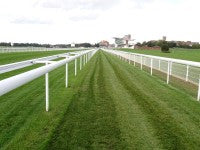
The overriding memory is of the great teamwork and the image of their beloved racing surface turning into a chess board of drains and slits, Adrian recalls. "We knew it would come back, nature is wonderful like that and we had lots of confidence in the team; yet even now, as I remember those drains going in, my heart rate still picks up a notch."
The turf went down on the south bend at the end of the year 2008, and Arden Lea finished the installation of the new Rainbird irrigation system, which has pop-up and the facility for boom irrigators around both the inside and outside of the track. The network was then connected to a brand new bore hole drilled 90 metres below the surface and a pump installed 35 metres down. The racecourse could now irrigate using water that had fallen some ten thousand years earlier and now lay trapped in the sandstone aquifer; in a city with a strong Viking and Roman heritage the team had unlocked a resource that predated even these inhabitants.
Demonstrating the capacity of this team to learn, even from adversity, came the new canter down. Reflecting on August 2008, an variation was made to the scheme to provide yet more protection for the main racecourse, and the turf canter down was added. At a 1,000 metres long and 3.5 metres wide, it takes horses safely towards the start of a sprint race. Constructed, drained, sand ameliorated and turfed with a further 3,700 square metres of LT6, Lindum's MD, Stephen Fell, is full of admiration at the way Adrian has managed the new sward.
"We've looked after it," Adrian admits. "The new turf is now laid on a sand based construction whereas, before, it was an alluvial flood plain. We've vertidrained, fed it and used a wetting agent when circumstances dictated. It's a new baby and it needs TLC."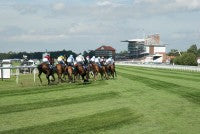
By the time of the Ebor Festival 2009 all the major improvements had been made, and the world's highest rated racehorse, Sea The Stars, was just one of the leading thoroughbreds to enjoy a victory over the rejuvenated surface. With four track records broken and some of the year's best racing witnessed, plaudits for the racing surface came in from such racing legends such as Frankie Detorri, Michael Dickinson, John Francome and Ian Balding.
However, the project was not quite complete as the new bend needed to be married in with the existing surface. The main contractors returned to adjust the racing levels on the inside of the track. "Horses race on a particular line," explains John Mallinson, "and, over time, as the surface drops and is built up again, usually with topdressing, a hard shoulder is created on the inside of the bends. We needed to correct this, remove the shoulder and restore levels." Some 6,000 metres of Fornells barrier and running rail were erected around both sides of the home straight and south bend, which can be moved two metres inwards or outwards to change the racing line and avoid the possibility of a new 'shoulder' developing. More importantly, the new wide home bend, at double the width of its predecessor, offers the Clerk of the Course the opportunity to offer fresh ground to run on, either when a meeting runs over several days or when they come in close succession. The new home bend will be a minimum 25 metres wide and have a consistent camber from inside to outside rail and will be available for use in the 2010 season
Obviously delighted with his new track, Adrian is more than pleased with the results of the whole improvement project. "Every piece has come together and we've received nothing but plaudits, from the owners, trainers, jockeys, everybody. We will keep learning and already this year we have a greater ability to manage the surface in the countdown to a raceday."
"It's been a major investment and William Derby and the whole Racecourse Committee has backed us to the hilt. The investment to do it right has been there and William has, almost literally, walked every step of the way with me," he concludes.
